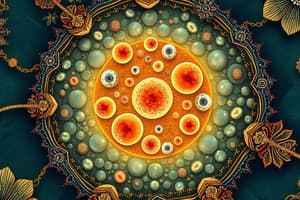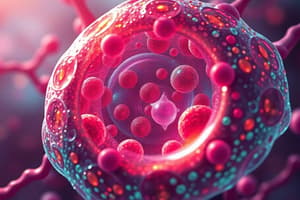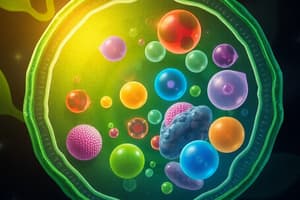Podcast
Questions and Answers
What is the function of the Golgi apparatus?
What is the function of the Golgi apparatus?
- Cell movement and stability
- Detoxify harmful substances
- Break down fatty acids
- Processing, sorting, and modifying proteins and lipids (correct)
Which organelle contains hydrolytic enzymes capable of breaking down organic matter?
Which organelle contains hydrolytic enzymes capable of breaking down organic matter?
- Peroxisomes
- Endoplasmic reticulum
- Lysosomes (correct)
- Mitochondria
What is the function of microfilaments in the cytoskeleton?
What is the function of microfilaments in the cytoskeleton?
- Organize DNA movement during cell division
- Provide structure to the nuclear envelope
- Involved in cell movement (correct)
- Break down fatty acids
Which organelle is responsible for cellular energy production?
Which organelle is responsible for cellular energy production?
Where do most cellular functions occur within the cell?
Where do most cellular functions occur within the cell?
What is the main function of secretory vesicles?
What is the main function of secretory vesicles?
What is the main function of the nucleus in a cell?
What is the main function of the nucleus in a cell?
Which type of cell has a membrane-bound nucleus?
Which type of cell has a membrane-bound nucleus?
What is the main function of the plasma membrane in a cell?
What is the main function of the plasma membrane in a cell?
Which type of cell has chloroplasts for photosynthesis?
Which type of cell has chloroplasts for photosynthesis?
What is a distinguishing feature of prokaryotic cells?
What is a distinguishing feature of prokaryotic cells?
How does the nuclear envelope of a nucleus function?
How does the nuclear envelope of a nucleus function?
Flashcards are hidden until you start studying
Study Notes
Cell Structure: An In-depth Look at the Building Blocks of Life
Introduction
Cells are the fundamental units of life, and understanding their structure is crucial to comprehending the functioning of living organisms. This article will delve into the intricacies of cell structure, providing a comprehensive overview of the main components of human cells.
Cell Types
Cells can be classified into two main types: prokaryotic and eukaryotic. Prokaryotic cells lack a membrane-bound nucleus, while eukaryotic cells have a nucleus surrounded by a nuclear membrane. Eukaryotic cells are further divided into plant and animal cells, with plant cells having chloroplasts for photosynthesis and animal cells relying on other organisms for energy production.
Cell Structure: What's Inside?
Plasma Membrane
The plasma membrane, also known as the cell membrane, is a thin, flexible barrier that separates the internal environment of the cell from the extracellular fluid. It consists of a double layer of phospholipids with embedded proteins. The membrane selectively allows the passage of molecules and serves to anchor adjacent cells together and to the extracellular matrix.
Nucleus
The nucleus is the largest organelle in the cell and is responsible for storing and transmitting genetic information. It is surrounded by a selective nuclear envelope composed of two membranes joined at regular intervals to form circular openings called nuclear pores. These pores allow RNA molecules and proteins modulating DNA expression to move through and into the cytosol.
Cytoplasm
The cytoplasm is the region outside the nucleus that contains cell organelles and cytosol, or cytoplasmic solution. It is where most cellular functions occur. The cytoplasm is divided into the cytosol, which is the watery jelly-like substance surrounding the organelles, and the organelles themselves.
Organelles
Organelles are membrane-bound structures within the cell that have specific functions. Some common organelles include mitochondria, responsible for cellular energy production; rough and smooth endoplasmic reticulum, involved in protein synthesis and lipid synthesis; Golgi apparatus, responsible for processing, sorting, and modifying proteins and lipids; secretory vesicles, which transport and release substances outside the cell; peroxisomes, which break down fatty acids and detoxify harmful substances; lysosomes, which contain hydrolytic enzymes capable of breaking down organic matter; microtubules and microfilaments, which form the cytoskeleton, providing cell movement and stability; and centrosomes, which organize DNA movement during cell division.
Cytoskeleton
The cytoskeleton is a network of protein fibers within the cytoplasm responsible for both cell movement and stability. It consists of three types of fibers: microtubules, intermediate filaments, and microfilaments. Microtubules are small tubes made from the protein tubulin and are involved in cell movement and providing pathways for secretory vesicles. Intermediate filaments are made of a variety of proteins, such as keratin and neurofilament, and provide structure to the nuclear envelope and anchor organelles. Microfilaments are the thinnest part of the cytoskeleton and are made of actin, a highly-conserved protein. Actin is both flexible and strong, making it useful in cell movement.
Conclusion
Cell structure is a complex and fascinating topic, providing essential insights into the workings of living organisms. Understanding the different components of cells and their functions is crucial for advancing our knowledge of biology and medicine.
Studying That Suits You
Use AI to generate personalized quizzes and flashcards to suit your learning preferences.




